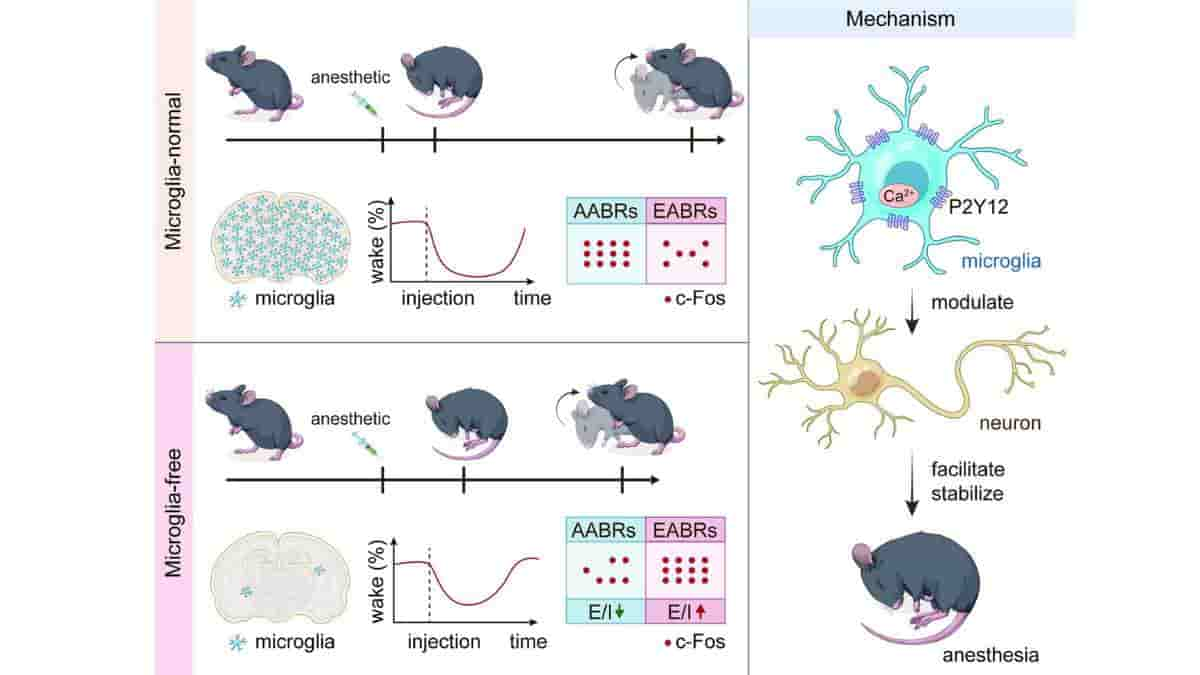Though it may come as a surprise to the millions of people who have general anesthesia for medical operations each year, the molecular process by which different anesthetics inhibit awareness is still unknown. Researchers may be one step closer after discovering how general anesthesia affects microscopic immune cells in the brain known as microglia.
“We found that microglia play an important role in regulating the body’s response to general anesthesia. Microglia are important immune cells in the central nervous system (CNS) that play critical roles in CNS function and dysfunction,”
said Bo Peng, a professor in the Institute for Translational Brain Research at Fudan University in Shanghai, China.
Anesthesia Resistance and CSF1R
Previous research on microglia has shown that the cells’ behavior changes during anesthesia, but this is the first study to show how microglia regulate neuronal activity in a brain region-specific manner and play an important role in how anesthesia works.
The first indication of how microglia influence anesthetic effectiveness was discovered accidently during other research and validated by more testing. Microglia depletion was induced in mice by inhibiting the signaling of the colony-stimulating factor 1 receptor (CSF1R).
When microglia were killed with PLX5622, a CSF1R inhibitor, there was a high resistance to anesthesia. This anesthesia resistance was detected using four different forms of anesthesia with two different receptors, and the findings were verified using electroencephalography (EEG) and electromyography (EMG) measures.
Brain Region-specific Regulation

Credit: He et al., eLife, 2023
Microglia also regulate brain network activity in a region-specific manner instead of a universal manner. Different parts of the brain regulate anesthesia induction and emergence.
Induction is when the animal receiving general anesthesia goes from consciousness to unconsciousness, while emergence is when the patient goes from unconsciousness to consciousness.
“We identified that microglia can facilitate and stabilize the response to general anesthesia via modulating the neuronal network in a brain region-specific manner. This is mediated by the microglial P2Y12 receptor and its downstream calcium signaling,”
said Peng.
Because of this brain region-specific regulation, microglial depletion not only delayed the time it took for anesthesia to work (delayed induction), but it also meant the anesthesia wore off faster (early emergence).
P2Y12 Receptor Neurological Disorder Links
The findings also suggest that microglia play a sophisticated and diverse role in orchestrating CNS function, rather than playing an indiscriminate role in negative feedback control.
Looking ahead, researchers want to understand more about the microglial cells and how the P2Y12 receptor relates to neurological disorders. This receptor is essential for a stable neuronal network, and it is suppressed in multiple neurological disorders.
Furthermore, researchers will continue to learn how general anesthesia works.
“Looking ahead, we plan to continue to dissect the mechanism of general anesthesia and study how microglia contribute to the central nervous system (CNS) function,”
said Yousheng Shu, who is also a professor at the Institute of Translation Brain Research at Fudan University.
Abstract
General anesthesia leads to a loss of consciousness and an unrousable state in patients. Although general anesthetics are widely used in clinical practice, their underlying mechanisms remain elusive. The potential involvement of nonneuronal cells is unknown. Microglia are important immune cells in the central nervous system (CNS) that play critical roles in CNS function and dysfunction. We unintentionally observed delayed anesthesia induction and early anesthesia emergence in microglia-depleted mice. We found that microglial depletion differentially regulates neuronal activities by suppressing the neuronal network of anesthesia-activated brain regions and activating emergence-activated brain regions. Thus, microglia facilitate and stabilize the anesthesia status. This influence is not mediated by dendritic spine plasticity. Instead, it relies on the activation of microglial P2Y12 and subsequent calcium influx, which facilitates the general anesthesia response. Together, we elucidate the regulatory role of microglia in general anesthesia, extending our knowledge of how nonneuronal cells modulate neuronal activities.
Reference:
- Yang He, Taohui Liu, Quansheng He, Wei Ke, Xiaoyu Li, Jinjin Du, Suixin Deng, Zhenfeng Shu, Jialin Wu, Baozhi Yang, Yuqing Wang, Ying Mao, Yanxia Rao, Yousheng Shu, Bo Peng (2023) Microglia facilitate and stabilize the response to general anesthesia via modulating the neuronal network in a brain region-specific manner. ELife 12:RP92252.
Top Image credit: He et al., eLife, 2023
